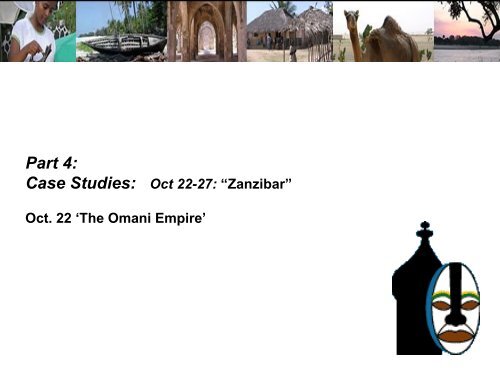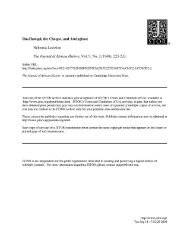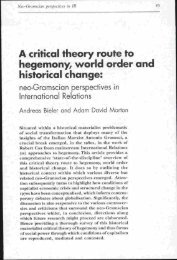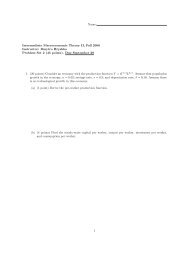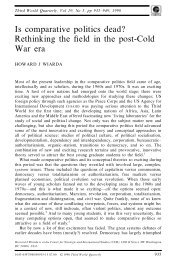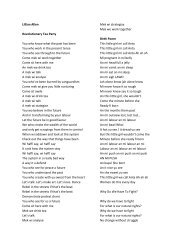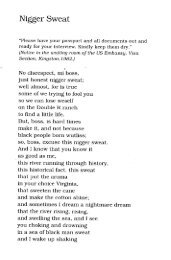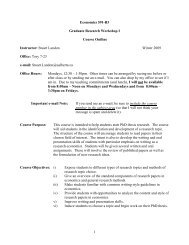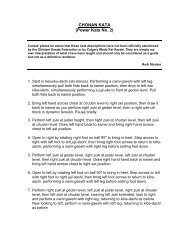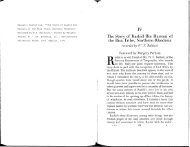Omani Empire
Omani Empire
Omani Empire
- No tags were found...
Create successful ePaper yourself
Turn your PDF publications into a flip-book with our unique Google optimized e-Paper software.
Part 4:Case Studies: Oct 22-27: “Zanzibar”Oct. 22 ‘The <strong>Omani</strong> <strong>Empire</strong>’
The <strong>Omani</strong>s in ZanzibarArrival Portuguese, sack Kilwa (1505) not only drew Europeans intoEast African sphere but <strong>Omani</strong>s from Arabian Peninsula• Oman: Ibadi Muslum sultanate, engaged in trade throughout IndianOcean, as far east as China• in 16 th c, both East African Coast and Oman’s capital Muscatbecame part of Portuguese ‘seaborne empire’• Portuguese occupied several East African ‘city states’ and Muscat
The <strong>Omani</strong>s in Zanzibar• Driven from Muscat 1750• Oman assisted several other East African ‘sultans’ to drive outPortuguese• then claimed control of the region, albeit measured in rights tomaritime trade rather than land-based political authority• Rebuilt power (political, economic) both at home and sea late 18 th c• Consolidated under rule of Sayyid Said bin Sultan (1804-1856)
The <strong>Omani</strong>s in Zanzibar• Oman reached zenith as regional power: possessions on both sidesof Gulf and East Africa• Sayyid Said concentrated on developing country’s economy andcommerce• made Zanzibar his ‘second capital ‘• concluded agreements with Britain and France• sent special envoy to United States• Built up navy, secured control of Persian Gulf
The <strong>Omani</strong>s in ZanzibarSayyid Said’s death posed succession problem:• dispute threatened Oman’s prosperityBritish VIceroy of India stepped in to mediate:• sultanate ‘divided’• Oman, Muscat to one son• Zanzibar, its ‘dependencies’ to the otherUnfortunately for Oman, Zanzibar was financial centre of empire:• ‘subsidy’ built into agreement (Zanzibar to subsidize Oman)• not enough• Oman declined, became dependent ‘backwater’ for next century• Zanzibar flourished
The <strong>Omani</strong>s in Zanzibar1830s, Sayyid Said chose Zanzibar, surrounding islands as centre ofclove and spice production:• Encouraged migration <strong>Omani</strong> merchants, traders• Drew on Indian trade network to attract Indian financial capital• Drew on East African slave trade to purchase slaves for plantationdevelopment1840 <strong>Omani</strong> capital moved definitively to Zanzibar
‘<strong>Omani</strong> Sultans’
‘<strong>Omani</strong> Sultans’
Sultan Bargash and Advisors
The <strong>Omani</strong>s in ZanzibarDeveloped complex plantation economy, rooted in trade to interior:• Invested in grain plantations on mainland (now Tanzania)• Expanded ivory, slave-trading network to interior• Indian merchants provided credit for goods that moved as far inlandas (today) eastern Congo• New settlements grew up facilitating, servicing, feeding network• ‘Swahili’ traders of mixed cultural descent operated caravans• famous ‘Tippu Tip’ epitomized system at most effective[see last lecture ‘who were these ‘Arabs’?]
Tippu TipExpanded Sultan’s ‘domains’ half-way across the continent takinglanguage, culture and religion with themBut raises key issues:- Tippu Tip: both <strong>Omani</strong> and ‘African’ancestry; Muslim, real name:Hamed bin Mohammed el Marjebi;served 8 sultans as explorer, guide,soldier, diplomat, judge, governorand slave merchant; 50 years of‘Carrying the flag and [<strong>Omani</strong>]civilization to its furthest geographicalboundaries’[see ‘Zanzibar Unveiled’ website, Resources]
Tippu Tip- Tippu Tip Swahili speaking- Shared Swahili culture of coast- typical of Burton’s ‘low coastdark ‘Arab’- Muslim but practicing ‘which Islam’:‘Swahili’ Islam of Coast?or‘Ibadi’ Islam of Oman?This last question became increasinglycritical
Identity in Zanzibar <strong>Empire</strong>Tippu Tip’s biography in particular epitomizes the complexities ofunderstanding the ‘Zanzibar case study’ with respect to a history ofIslam and Muslim Peoples:• Challenges idea of unidirectional ‘gateways’ that were open forIslam in universal fashion• Raises thorny issue not only of who was Arab, but – who was aSwahili?• And what, exactly, was an <strong>Omani</strong>?• Complicates question of ‘intrusion’ and foreign power: <strong>Omani</strong> ascolonized by British, Swahili as colonized by <strong>Omani</strong>, ‘Africans’(many slaves or freed slaves) as exploited by both[First, third points further developed in “Another ‘Andalus’…”, last in ‘Rashidbin-Hassani’, both Additional Readings’; third “Being Baysar…”, Resources]
Identity in Zanzibar <strong>Empire</strong>Reference here to Amal Ghazal’s article “Another ‘Andalus’…”:• She works the ‘frontier’ between African and Middle Eastern historywith respect to Islamic intellectual networks• Comments/arguments relevant both to ‘<strong>Omani</strong> <strong>Empire</strong>’ and ‘BritishProtectorate• Here explaining (in ‘historiography’ context) why <strong>Omani</strong>s not fullyincorporated into ‘Muslim’ worlds of either Africa or Middle East• Key: taking seriously their Islamic beliefs, politics, communications,networks
Identity in Zanzibar <strong>Empire</strong><strong>Omani</strong> elite in Zanzibar characteristic of Islamic studies:• Muslim elite, members belong to sect called ‘Ibadism’• Islamicists have devoted little attention to Ibadism• one of earliest sects of Islam• offshoot of Kharijism (had presence in early West Africa)• Initially, intolerant of other Muslims – differ from Sunni and Shia inaspects of beliefs• has generated limited interest among researchers• ‘double marginalization’, due to sectarian affiliation and togeographic location [Ibadi ‘outside mainstream’; Zanzibar ‘outsidegeographical ‘centre’].
Identity in Zanzibar <strong>Empire</strong><strong>Omani</strong> Ibadis in Zanzibar as much part of African as of Arab/MiddleEastern history: fields complementary, overlapping• definition of ‘Arab’ allowed to defy geography but an ‘African’ oftenmade to manipulate geography, insulating itself within borders,rigidly marked by the demarcations of a specific color, race, tribe,religion, or language.• Arabs and Islam do not belong within those borders• do not usually fit the categories of ‘African’ races and religions• tend to be rejected as part of African heritage [eg ‘Arab’ North Africaand Sahara carved out of ‘African’ history assuming they belong toanother category of history]• communities born out of this conjuncture of histories remainmarginalized• This is the case of the <strong>Omani</strong> ruling elite in Zanzibar[Ghazal, paraphrased p.45 “Another Andalus…”]
Identity in Zanzibar <strong>Empire</strong>“The ambitious plan of its founder, Sayyid Sa‘īd (r. 1806-1856), totransform Zanzibar into a major economic center and aninternational seaport opened the gates for a flood of migrants fromOman as well as Hadramawt and India.A number of those were ‘ulama whose presence in Zanzibarinstitutionalized the long presence of Islam on the island andresulted in an unprecedented spread of Islamic institutions and of aliterate Islamic tradition that was Arabic in character. They alsobrought ideas and ideologies, ties and connections, and along withthe rulers, they changed the intellectual and political landscape ofZanzibar.Together they pulled Zanzibar closer to the Arab and Muslim world”[will be explored further next day in context of ‘British Protectorate’]
Ibadi ScholarsSheikh Abdulla Saleh Farsy:A 20th Century example of a very longline of Islamic Scholars from Zanzibar.His most famous contribution to Islamwas the publication of his 807-pageQUR'AN TAKATIFU (Glorious Qur'an).Sheikh Abdullah was appointed theInspector General of primary schools onZanzibar and Pemba in 1949, theHeadmaster of the Arabic mediumSchool in 1957 and the Chief Kadhi ofZanzibar in 1960. He left the Isles afterthe revolution of 1964 and died in Omanon November 9, 1982.[text from ‘Zanzibar Unveiled’, Resources]
Identity in Zanzibar <strong>Empire</strong>Sets context for two stories revealing different, yet intersectingdynamics of emergent society:• “the marriage that never was” [from ‘Being Baysar…’, Resources]• “story of Rashid bin-Hassani”
Marriage that never was…“Sulayman bin Sleyum had brought a proposal to marry Zuwayna bintMuhammad. It must have been sometime before 1910. Zuwaynahad not been in Tabora long—she had fled into German East Africafrom the Congo Free State after her father, Muhammad bin Khamisal-Kiyumi (an Arab born in Oman) had been killed fighting theBelgians in the late 1890s. Both Sulayman and Zuwayna were partof a community of <strong>Omani</strong>s who lived in Tabora, a bustling town onthe central plateau of East Africa. Tabora had grown up in the midnineteenthcentury from a series of hamlets in the Unyanyemberegion, more than 500 miles from the Indian Ocean. …
Marriage that never was…Groups of Arabs and coastal traders established a base for themselvesin Unyanyembe in the 1830s and 40s by allying with local chiefs,making them business partners and fathers-in-law. The best knownexample of this is Muhammad bin Juma al-Murjebi, whose sonHamed, also known as Tippu Tip, was one of the most famoustraders in the interior in the late nineteenth century. Muhammad binJuma married Karunde, a daughter of a Nyamwezi chief in the1840s and, in so doing, established a base for himself and otherpeople who had come from the coast to that vicinity.*[* suggests bin Juma had both an <strong>Omani</strong> wife (Tippu Tip’s mother) and anAfrican wife – probably not unusual.]
Marriage that never was…As the caravan trade in ivory and slaves grew in the nineteenth century,Tabora became a principal way-station and cross roads for caravanscoming from Zanzibar and coastal towns. By the 1890s more than80,000-100,000 porters were passing through Tabora every year,and with them came more people from the coast—a variety of Arabsand Swahili people—as well as Africans from all parts of the interior.From Tabora the routes continued north to the kingdom of Buganda,west to Lake Tanganyika and the Congo, and southwest to theslave-hunting regions south of Lake Tanganyika …
Tabora and the Slave Trade
Marriage that never was…… the trading post and way-station of Tabora was far from the interioroases of Arabia, and the number of Arabs who claimed <strong>Omani</strong>heritage in Tabora was not large. In the early years of the town, thesize of the community varied seasonally, as traders arrived anddeparted with the caravans.Increasing numbers of Arabs and coastal Muslims settled there in thelatter half of the nineteenth century, making Tabora the mostimportant Muslim town in the interior. Men of <strong>Omani</strong> descentcontrolled important sectors of the economy and, through businesspartnerships, linked the Congo River basin with the Indian Ocean.
Marriage that never was…Zuwayna, the bride to be, was born in East Africa. Her father was bornin Oman and emigrated to East Africa in search of newopportunities.With the expansion of trade and trade routes throughout eastern andcentral Africa, many Arabs, coastal people, and their clients movedinto the Congo Free State where ivory was plentiful and the marketgood for trade items from Zanzibar.In the 1890s, representatives of Belgium’s King Leopold and theirmercenaries came into increasing competition with the east coastand Indian Ocean traders. They fought openly for the first half of thatdecade, and many Zanzibari Arab and Swahili people escaped orwere killed.
Marriage that never was…Zuwayna and her two sisters crossed Lake Tanganyika to Kigoma inGerman East Africa and then went to Tabora where their father’sbusiness partner, Sulayman bin Zahir al-Jabri, resided.Sulayman had been established in the interior for many years andenjoyed good credit in Zanzibar from the Indian financiers of theivory trade. Zuwayna lived with Sulayman and his family, and it waswith him that the young suitor Sulayman bin Sleyum was to finalizethe wedding.
Marriage that never was…Old Sulayman bin Zahir was ill when the wedding day arrived, and hehad to ask his trusted slave, Marjani bin Othman to conclude thewedding arrangements. Everyone wore their finery, and whenSulayman bin Sleyum arrived, he was well dressed in <strong>Omani</strong> style,with a long white kanzu [dishdasha] and a joho, the woolen cloakfavored by well-to-do Arabs for occasions such as these. Sulaymanbin Sleyum greeted Marjani and the assembled group, “Al-Salaam‘alaykum,” and the servant Marjani answered, “Wa’alaykum alsalam,ya shaykh Sulayman.”Sulayman corrected the slave. He was not a shaykh, he said, but aservant of shaykhs. With that, as the story is told, the wedding wascalled off. Sulayman bin Sleyum was a baysar, and thus, to <strong>Omani</strong>sand their trusted slaves, unfit for marriage to an <strong>Omani</strong> of noblebirth.
Marriage that never was…‘Baysar’ is not a clear status but suggests an <strong>Omani</strong> Arab descendedfrom slave status – or at least not of ‘pure blood’; in Oman occupiedsomewhat inferior position in society“This failed attempt at marriage between two people of <strong>Omani</strong> descentin the town of Tabora, several hundred miles from Zanzibar andseveral thousand miles from Oman, hinged on notions of statusimported from Oman.<strong>Omani</strong> migrants were one of the groups that traveled to the interior ofEast Africa, but these migrants and itinerants identified subgroupsamong themselves, casting doubt on the idea of a single Arabidentity in East Africa. “
Rashid bin HassaniStory of Rashid bin Hassani:• Story contemporary with ‘marriage that never was’• Rashid captured in interior (near Lake Nyasa) by Nguni (African)slave raiders• Sold to farmer; resold to Yao (African) slave trader• ‘well treated, clothed, fed• Reached coast, sold to Manga Arab from Kilwa, who lived inZanzibar• Slave market ‘master’ (Arab) came to purchase him (and others)• Then sold to sister of Sultan Bargash, Bibi Zem-Zem
Rashid bin HassaniRashid bin Hassani’s area of capture and sales
Sultan’s SisterThis is NOT Bibi Zem-Zembut Shamboa, who was daughterof Khaled, son of Sayyid Said.Unclear to which Sultan shewas sister.
Rashid bin HassaniBegan life on her ‘shamba’ (plantation:• Given to slave couple who had no children• Circumcised, taught Islam and to read Qur’an• Given new Muslim name• Later married to another slave (born in slavery) of Bibi Zem-Zem, his(slave) father paid dowery• Continued to work ‘under Bibi’s protection’; now allowed to keepwages
Rashid bin HassaniMet Swahili porters working with Europeans (British) in Uganda:• Began life as ‘porter’ [could have been one of the porters we met inTabora]• Next 5 years, three safaris: he was paid half his wages, the otherhalf went to Bibi Zem-Zem (European ‘policy’)Next phase as ‘askari’ (soldier) for Sultan:• Describes battles, officers• Note presence of Comorian and Swahili officers, Persian engineer• Rashid’s ‘company’ forcibly enlisted
Sultan’s Soldiers
Askari with Convicts (Zanzibar)
Rashid bin HassaniNext phase in Mombassa:• Took Kikyu (African) wife• While there, Bibi Zem-Zem died: all her 500-600 slaves freed• Story of jealous wife: note by editor “Rashid, as a Moslem and adetribalized African, lived like a Swahili.”• Clear that Rashid and his wife were regarded by other Swahili as‘being Swahili’
Rashid bin HassaniFrom Rashid’s Story:• We see completely different slave-trading system, one that was inthe hands of ‘Africans’ of the interior until coastal markets reached• Even on coast/Zanzibar, different ‘categories’ of Arabs involved (egManga Arab, ‘Arab’)• Complex process of ‘becoming Muslim’ as slave, moving back ontomainland (eventually he moved further into the interior), marryingwith presumably non-Muslim women as freed-slave• Reveals complexity of ‘being Swahili’ as well but clearly came toinclude freed-slaves in many instances• Swahili still distinguished from ‘African’ and from ‘Arab’[see ‘Wonders of the African World’: ‘Swahili Coast’ – ‘Retelling’ videos]
Swahili Identity/ies[see ‘Wonders of the African World’: ‘Swahili Coast’ – ‘Retelling’videos]• Sheikh Badawi: a respected Lamu [Island of] elder and Muslimscholar who claims pure Arab lineage. The sheikh believes that theSwahili people are descendants of Arab men who took Africanconcubines. Ali Salim, the sheik's grandson, translates• Tour Guide, Mombasa: who offers a complex [somewhat confusing!]definition of the Swahili people• Ummi Mahsouda Alley Hamid: descendant of Tippu Tip “notoriousblack slave trader”, Zanzibar who rationalizes that the Arab systemof slavery was purely business and that it was different fromAmerican slavery [Henry Louis Gates, Jr.’s words – not mine!
Swahili Identity/iesc. 1890
‘Swahili’ Identity/ies
‘Swahili’ Identity/ies‘IvoryMerchant’‘Zanzibari’


